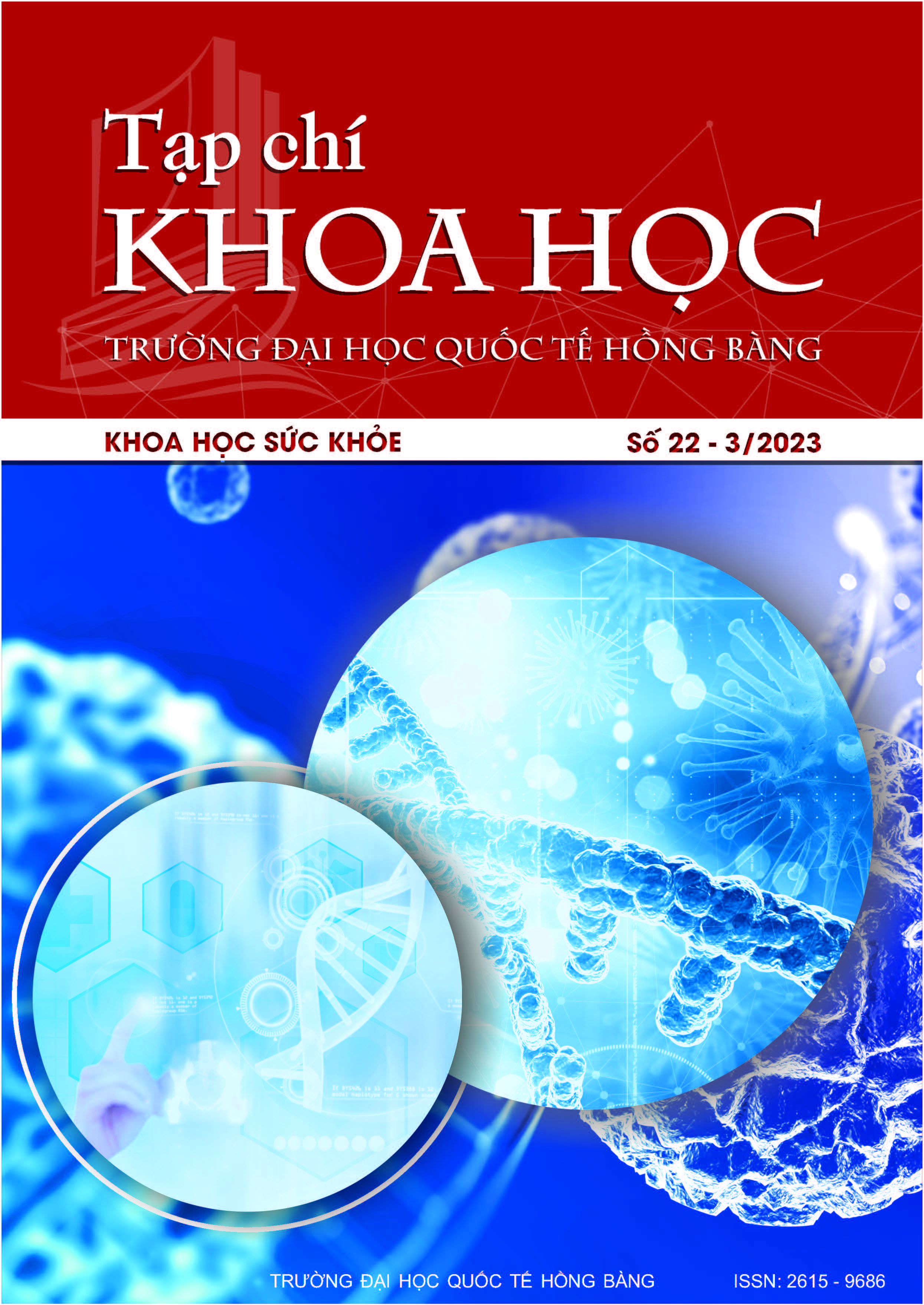Vai trò của MicroRNA-1290 tuần hoàn ngoại bào trong sàng lọc ung thư: báo cáo tổng hợp y văn và phân tích gộp
Các tác giả
DOI: https://doi.org/10.59294/HIUJS.22.2023.293Từ khóa:
miR-1290 tuần hoàn ngoại bào, ung thư, chẩn đoán, phân tích gộpTóm tắt
Đặt vấn đề: MicroRNA-1290 (miR-1290) tuần hoàn ngoại bào là dấu ấn tiềm năng trong sàng lọc ung thư. Mục tiêu nghiên cứu: Nghiên cứu này nhằm tổng hợp y văn và phân tích gộp để làm rõ khả năng chẩn đoán của miR-1290. Đối tượng và Phương pháp: Dữ liệu nghiên cứu gốc từ cơ sở dữ liệu PubMed/MEDLINE, Web of Science, Cochrane Library và Google Scholar được sử dụng để phân tích gộp, ước tính giá trị dưới đường cong ROC (AUC), tỷ suất chênh chẩn đoán (DOR), độ nhạy, độ đặc hiệu của miR-1290. Kết quả: 19 nghiên cứu với 2,720 trường hợp (1,578 ung thư, 1,142 đối chứng) được chọn vào phân tích. Giá trị AUC, DOR, độ nhạy và độ đặc hiệu của miR-1290 trong sàng lọc ung thư lần lượt đạt 0.883 (95%CI: 0.839 - 0.891), 23.8 (95%CI: 16.5 - 34.3), 77.1% (95%CI: 70.7- 82.4) và 89.5% (95%CI: 85.2 - 92.7). Tỷ số khả dĩ dương tính (PLR) và âm tính (NLR) đạt 6.04 và 0.33. Sau khi hiệu chỉnh nguy cơ sai lệch do xuất bản, chỉ số DOR đạt 16.5 (95%CI: 10.5 - 25.8). Độ đồng thuận chỉ số DOR cao sau khi loại trừ ba báo cáo với giá trị ngoại vi (I2 = 20.6%, P = 0.204). Kết luận: miR-1290 tuần hoàn ngoại bào có thể sử dụng trong sàng lọc ung thư với hiệu suất chẩn đoán tốt, độ nhạy và độ đặc hiệu ở mức chấp nhận được.
Abstract
Background: MicroRNA-1290 (miR-1290) is an oncogene that regulates multiple genes and pathways related to malignant tumors. Recent individual studies indicated that circulating miR-1290 is a potential biomarker for cancers. Objectives: We aimed to clarify the diagnostic role of extracellular circulating miR-1,290 in screening cancers by a systematic review and meta-analysis. Materials and Method: We searched databases of PubMed/MEDLINE, Web of Science, Cochrane Library, and Google Scholar for relevant studies, extracted original data, then analyzed for estimating the pooled area under the curve (AUC), diagnostic odds ratio (DOR), sensitivity, and specificity of miR-1290 in classifying cancers. Results: After the screening, selection, and quality assessment, 19 eligible reports with a total of 2,720 cases (1578 cancers, 1,142 controls) enrolled in the final analysis. Of notes, the pooled AUC, DOR, sensitivity, and specificity of circulating miR-1290 in cancer surveillance were 0.883 (95% confidence interval [CI]: 0.839 - 0.891), 23.8 (95%CI: 16.5 - 34.3), 77.1% (95%CI: 70.7 -82.4), and 89.5% (95%CI: 85.2 - 92.7), respectively. The positive and negative likelihood ratios were 6.04 and 0.33, respectively. For the potential publication bias, the overall DOR was adjusted to 16.5 (95%CI: 10.5 - 25.8). By removing three outliers, the heterogeneity in DOR was not significant (I2 = 20.6%, P = 0.204). Conclusion: The results of this study suggest that circulating miR-1290 might serve in cancer screening with good performance, acceptable sensitivity, and specificity.
Tài liệu tham khảo
[1] M.J. Page, J.E. McKenzie, P.M. Bossuyt, … D.Moher, “The PRISMA 2020 statement: An updated guideline for reporting systematic reviews,” PLoS Medicine, vol. 18, no. 3, article e1003583, 2021.
[2] A. Li, J. Yu, H. Kim, … M. Goggins, “MicroRNA array analysis finds elevated serum miR-1290 accurately distinguishes patients with low-stage pancreatic cancer from healthy and disease controls,” Clinical Cancer Research, vol. 19, no. 13, pp. 3600-3610, 2013.
[3] A. Torres, K. Torres, A. Pesci, … R. Maciejewski, “Diagnostic and prognostic significance of miRNA signatures in tissues and plasma of endometrioid endometrial carcinoma patients,” International Journal of Cancer, vol. 132, no. 7, pp. 1633-1645, 2013.
[4] H. Imaoka, Y. Toiyama, H. Fujikawa, … M. Kusunoki, “Circulating microRNA-1290 as a novel diagnostic and prognostic biomarker in human colorectal cancer,” Annals of Oncology, vol. 27, no. 10, pp. 1879-1886, 2016.
[5] Y. Nagamitsu, H. Nishi, T. Sasaki, … K. Isaka, “Profiling analysis of circulating microRNA expression in cervical cancer,” Molecular and Clinical Oncology, vol. 5, no. 1, pp. 189-194, 2016.
[6] P. Karasek, N. Gablo, J Hlavsa, … V. Prochazka, “Pre-operative plasma miR-21-5p is a sensitive biomarker and independent prognostic factor in patients with pancreatic ductal adenocarcinoma undergoing surgical resection,” Cancer Genomics and Proteomics, vol. 15, no. 4, pp. 321-327, 2018.
[7] M. Kobayashi, K. Sawada, K. Nakamura, … T. Kimura, “Exosomal miR-1290 is a potential biomarker of high-grade serous ovarian carcinoma and can discriminate patients from those with malignancies of other histological types,” Journal of Ovarian Research, vol. 11, no. 1, article 81, 2018.
[8] N. Ta, X. Huang, K. Zheng, … J. Zheng, “miRNA-1290 promotes aggressiveness in pancreatic ductal adenocarcinoma by targeting IKK1,” Cellular Physiology and Biochemistry, vol. 51, no. 2, pp. 711-728, 2018.
[9] F. Tavano, D. Gioffreda, M.R. Valvano, … A. Andriulli, “Droplet digital PCR quantification
of miR-1290 as a circulating biomarker for pancreatic cancer,” Scientific Reports, vol. 8, no. 1, article 16389, 2018.
[10] H. Sun, L. Wang, Q. Zhao, and J. Dai, “Diagnostic and prognostic value of serum miRNA-1290 in human esophageal squamous cell carcinoma,” Cancer Biomarkers, vol. 25, no. 4, pp. 381-387, 2019.
[11] L. Zavesky, E. Jandakova, V. Weinberger, … A. Horinek, “Ascites-derived extracellular microRNAs as potential biomarkers for ovarian cancer,” Reproductive Sciences, vol. 26, no. 4, pp. 510-522, 2019.
[12] X. Liu, X. Xu, B. Pan, … S. Wang, “Circulating miR-1290 and miR-320d as novel diagnostic biomarkers of human colorectal cancer,” Journal of Cancer, vol. 10, no. 1, pp. 43-50, 2019.
[13] J. Wei, L. Yang, Y.N. Wu, and J. Xu, “Serum miR-1290 and miR-1246 as potential diagnostic biomarkers of human pancreatic cancer,” Journal of Cancer, vol. 11, no. 6, pp. 1325-1333, 2020.
[14] Y. Wu, J. Wei, W. Zhang, … J. Xu, “Serum exosomal miR-1290 is a potential biomarker for lung adenocarcinoma,” OncoTargets and Therapy, vol. 13, pp. 7809-7818, 2020.
[15] M.W. Kim, H. Koh, J.Y. Kim, … S.I. Kim, “Tumor-specific miRNA signatures in combination with CA19-9 for liquid biopsy-based detection of PDAC,” International Journal of Molecular Sciences, vol. 22, no. 24, article 13621, 2021.
[16] Y. Shi, Y. Zhuang, J. Zhang, M. Chen, and S. Wu, “Four circulating exosomal miRNAs as novel potential biomarkers for the early diagnosis of human colorectal cancer,” Tissue and Cell, vol. 70, article 101499, 2021.
[17] L. Xu, Y. Cai, X. Chen, Y. Zhu, and J. Cai, “Circulating MiR-1290 as a potential diagnostic and disease monitoring biomarker of human gastrointestinal tumors,” BMC Cancer, vol. 21, no. 1, article 989, 2021.
[18] H.G. Jiang, C.H. Dai, Y.P. Xu, … J. Li, “Four plasma miRNAs act as biomarkers for diagnosis and prognosis of non‑small cell lung cancer,” Oncology Letters, vol. 22, no. 5, article 792, 2021.
[19] H. Jeon, S.M. Seo, T.W. Kim, … S. Jeon, “Circulating exosomal miR-1290 for diagnosis of epithelial ovarian cancer,” Current Issues in Molecular Biology, vol. 44, no. 1, pp. 288-300, 2022.
[20] M. Hassan, S.M. Nasr, N.A. Amin, … M. Elzallat, “Circulating liver cancer stem cells and their stemness-associated microRNAs as diagnostic and prognostic biomarkers for viral hepatitis-induced liver cirrhosis and hepatocellular carcinoma,” Non-coding RNA Research, vol. 8, no. 2, pp. 155-163, 2023.
Tải xuống
Tải xuống: 91











